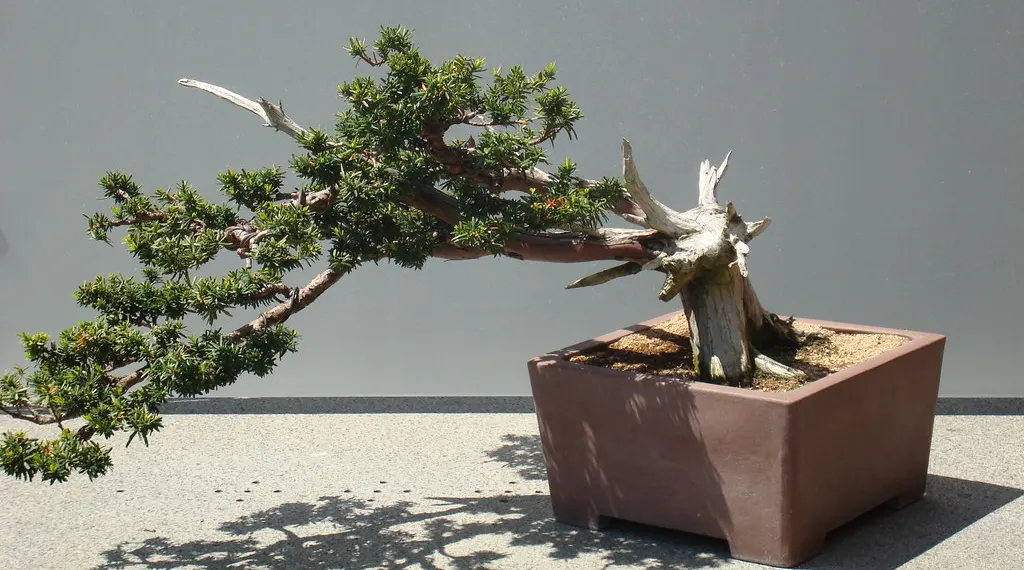How to Identify a Japanese Yew
The Japanese Yew (Taxus cuspidata) is a native of not only Japan but also Russia, China, and Korea.
This tree is technically a conifer but they do not produce cones as most conifers do. When left in its natural state, and not constrained as a bonsai, this plant will grow to a height of 30 to 50 feet.
Yew trees are tolerant of most growing conditions and as they are native to countries where winters are bitterly cold, they are extremely cold tolerant.
Yew trees are often used, in gardens, for topiaries and hedges and they handle pruning very well. This makes them ideal for bonsai and very tolerant of mistakes. Image courtesy of 4.0 International
Image courtesy of 4.0 International
This plant is deadly
All species of yew, including the Japanese Yew, are highly poisonous to humans and animals. This is a fact that you must consider when deciding to use this plant in one of your bonsai creations. The plants must be kept away from dogs, cats, and children. The only animal that is resistant to the poison is the white-tailed deer, who relish the foliage!
The bark, seed, and leaves all contain taxine alkaloids, which are toxic chemicals that cause trembling, diarrhea, vomiting, breathing difficulty, and seizures, and lead to death.
Strangely enough, the fleshy part of the berry is not poisonous. It is slightly sweet and watery but the berries are small and the work needed to strip the flesh away from the seed (which is highly toxic), and the danger of inadvertently ingesting the seed, makes this an unrewarding exercise.
The poison must be ingested to work, so handling the plant will not cause poisoning nor will it cause contact dermatitis.
If you suspect that an animal or human has eaten any part of this plant, seek medical help immediately.
How to Identify a Japanese Yew
To identify a Japanese Yew look for these characteristics:
- The plant is a type of conifer so it has needle-type leaves
- Needles are dark green on top and lighter in color underneath. Sometimes the underside may be tinged with yellow.
- Needles are approximately 1” (2,5cm) long.
- The needles grow on both sides of the stem.
- The needles grow in a spiral pattern down the stem.
- The needles feel soft, not hard like those of other conifers.
- The bark is reddish-brown in color and scaly in texture, but very fragile.
- Female plants bear berries, called arils, that turn from green to bright red in the late summer.
- Each berry contains one seed that is also poisonous.
- Male yew trees produce flowers that resemble little Brussel Sprouts.
- These flowers hang down and once their pollen has been released they wither and die.
Cultivars of Japanese Yew
There are many cultivars of Japanese Yew from which you can choose. Here are a few with which you can experiment:
- “Aurescens” – this cultivar grows to about one meter but its foliage is appealing. The needles start life bright yellow in color and gradually turn dark green.
- “Densa” – as its name implies this is a spreading type of plant that, in its natural form, will grow to eight feet wide
- “Emerald Spreader” – this is another spreading cultivar that will naturally only grow to between two and three feet high.
- “Capitata” – this is a yew tree and left in the garden would reach 20 – 30 feet.
- “Nana” – this is another spreading form of yew.

Conclusion
The Japanese Yew is an ideal tree to use for bonsai and they can easily be trained into any shape. They make beautiful leaf pads and new shoots can readily be encouraged.
Be aware of their toxicity and keep the plants away from small children and pets.
These are beautiful plants that will give years of pleasure to the bonsai enthusiast.






